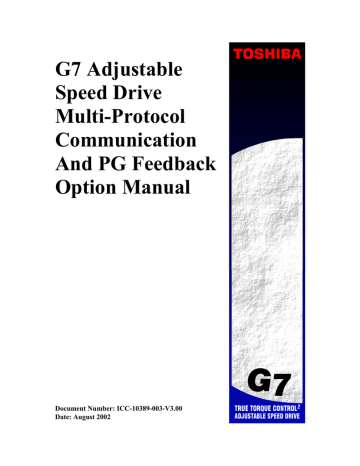advertisement

9. Profibus Interface
This section applies to ASD-MULTICOM-A option boards only.
9.1 Feature Summary
The Multicom interface provides a wide array of network data access and drive control features.
Combined with the flexible configuration and high-speed data transfer capabilities of the Profibus network, this allows powerful networked control and monitoring systems to be designed. Some of the main features provided by the Multicom interface which allow for this control and configurability are briefly described here:
Protocol
Profibus DP (Decentralized Periphery) as specified in European standard EN 50170. The Multicom interface can also co-exist simultaneously on networks using Profibus-FMS.
Network Baud Rates
Supports all Profibus baud rates from 9.6kbaud to 12Mbaud. The network baud rate is automatically detected and continuously monitored during operation; no parameter settings are necessary.
Power Supply
Self-contained. Powered directly from the connected drive. No external power supply devices or connections are required.
Isolation
The drive is fully optically isolated from the Profibus network. By using optically isolated connections, grounding differential problems are eliminated and noise immunity characteristics are greatly improved.
Global Control Functions
• Freeze mode:
Input (monitor) data values are held constant within the Multicom interface until the next “freeze” command or an “unfreeze” command is received. Used primarily for synchronized monitoring of multiple Profibus nodes.
• Sync mode:
Output (control) data values are held constant within the Multicom interface until the next “sync” command or an “unsync” command is received. Used primarily for synchronized control of multiple Profibus nodes.
• Clear_Data:
Network Watchdog
All output (control) data values are cleared to “0”.
A network watchdog function is always operating within the Multicom interface (if selected at time of unit commissioning). In the event of a disconnection from the Profibus network or loss of the network master, the Multicom interface will automatically set its control data to 0.
G7 ASD Multi-Protocol Communication Option and PG Feedback Option Manual 19
Indicator
A green LED (LED1) is provided to indicate when the Multicom interface has achieved the
DATA_EXCHANGE state with the Profibus network master. This serves as a convenient indicator that the Profibus master and Multicom interface are configured properly and are exchanging data.
Profibus Network Connector
The network interface is a standard DB-9 female connector. The metallic housing of the DB-9 connector is typically connected to the network shield in the attached Profibus connector. The DB-9 housing can, in turn, then be connected to earth ground if desired.
Input/Output Data
The Multicom interface’s cyclic output (control) and input (status) data sizes are selectable (modular) in
16 different configurations representing sizes of between 4 and 40 bytes.
Via these data structures, any data item (command data, monitor data and configuration parameters) available in the drive can be accessed. For detailed explanations of the format and usage of the input/output data, refer to section 9.4.
G7 ASD Multi-Protocol Communication Option and PG Feedback Option Manual 20
advertisement
Related manuals
advertisement
Table of contents
- 9 Installation Precautions
- 10 Maintenance Precautions
- 10 Inspection
- 10 Storage
- 10 Disposal
- 12 Installation Procedure
- 14 Wiring
- 15 PG Feedback Enable Setting
- 15 PG Power Supply Voltage Selection
- 16 Pulse Input Selection
- 17 PG Feedback Connection
- 20 Maximum Input Frequency Using an Open Collector Encoder
- 23 Profibus DP Configuration
- 24 Modbus RTU Configuration
- 25 DeviceNet Configuration
- 26 Feature Summary
- 28 Profibus Interface Connection
- 28 Unit Addressing
- 29 Profibus Exchanged Data Structures
- 29 Output (Control) Data Format
- 32 Input (Status) Data Format
- 38 Diagnostics
- 39 Asynchronous Drive Parameter Access
- 39 Parameter Number / Action Output Words
- 40 Parameter Number / Action Input Words
- 41 Drive Parameter Access Procedure
- 42 Register Access Error Codes
- 42 Parameters
- 43 Physical Layer
- 44 Modbus RTU
- 44 Configuration
- 44 Communication Formats
- 45 Modbus/ASD Register Mappings
- 46 ASD Scan Registers
- 48 Supported Modbus Functions
- 49 Programmable Pointer Registers
- 49 Response Delay Timer Function
- 50 LED Indicators
- 50 Register Summary
- 52 Feature Summary
- 53 Unit Addressing
- 53 Grounding
- 53 Connection Information
- 53 Connection Sizes
- 54 I/O Assembly Instances
- 55 Object Specifications
- 56 Identity Object
- 58 Message Router
- 59 DeviceNet Object
- 61 Assembly Object
- 65 Connection class
- 69 Control Supervisor Object
- 72 Motor Data Object
- 74 AC/DC Drive Object
- 79 Parameter Class
- 80 Network Communication Loss Action

